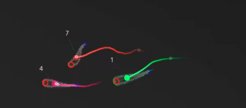User-friendly AI for animal behavior
Developed by PhD student Tristan Walter and Iain Couzin, the easy to use tool automatically tracks hundreds of individual animals.

Computer programs that measure and analyze animal movement are fast becoming indispensable for the study of behavior. Animal movements are highly complex, and quantifying them can be a laborious and time-consuming task. Automated tools, however, are enabling scientists to conduct more advanced behavioral experiments that provide deeper insight into how animals make decisions based on what they sense in their environment.
A particular challenge for the quantitative study of behavior has been how to automatically track a group of individuals in video recordings of animals. Maintaining information about large numbers of individuals still presents computational challenges, particularly with respect to memory size and computation speed. Additionally, many animals prefer to hide under cover or behind other individuals, and often look very similar to each other, which makes it harder—or indeed impossible—to keep track of who is who. While past tools had no other choice than relying on attaching physical markers to animals in order to tell individuals apart, newer tools are using machine learning techniques to automatically perform this task.
Now, PhD student Tristan Walter and Iain Couzin have created a system that can track up to 100 individuals while maintaining their separate identities without the need for physical markers. With the development of a new algorithm for training and applying an artificial neural network used to visually identify individuals, their tool performs much faster (2.5-46.7 times) than comparable software and requires 2-10 times less memory at the same time. In addition to tracking and individual identification, the tool also integrates other features for studying animal behavior, such as estimating an individual’s 2D posture and visual field, and the ability to track positions of up to 256 individuals in real-time.
All of these methods are integrated into a single, intuitive open-source tool with a rich graphical user interface and available (and steadily extending) online documentation. Being fast, memory efficient, easy to use, and with powerful integrated tools, TRex will lower barriers of entry into, and enable more ambitious approaches to, the quantitative study of behavior.
Original publication: Tristan Walter and Iain D Couzin (2021) TRex, a fast multi-animal tracking system with markerless identification, and 2D estimation of posture and visual fields. eLife 2021;10:e64000. doi: 10.7554/eLife.64000













